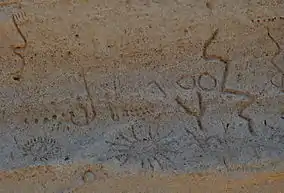Petroglyph Point Archeological Site
The Petroglyph Point is an archaeological site within the Lava Beds National Monument, located southeast of Tulelake, California. Petroglyph Point contains one of the largest panels of Native American rock art in the United States. The petroglyphs are carved along the face of a former island of ancient Tule Lake, in a region historically of the Modoc people territory. The Petroglyph Point Archeological Site was listed on the National Register of Historic Places in 1975, while the Lava Beds National Monument Archeological District was listed in March 1991.[1][2]
| Petroglyph Point Archeological Site | |
|---|---|
IUCN category III (natural monument or feature) | |
 | |
 | |
| Location | Siskiyou County, California, USA |
| Nearest city | Tule Lake |
| Coordinates | 41°50′42″N 121°23′28″W |
| Area | 1,600 |
| Established | May 29, 1975 |
| Governing body | National Park Service |
| Designated | 1975 |
| Reference no. | 75000178[1] |
Because of the number of times the petroglyphs may have been inundated in water as Tule Lake rose and fell around the cliff face, the age of the individual petroglyphs is complicated to calculate based on weathering.[3] Most estimates date these carvings back between 2000 and 6000 years ago.
Unlike rock art in other areas of the West, many of the images seem to be mostly geometric patterns instead of depictions of people and animals. Because of the tribal fracturing produced during the Modoc War and most of the Native Americans from the region having long since moved into other areas, no ethnographic study was ever done with Modoc peoples to record the probable meaning of the petroglyphs.[3]
References
- "National Register Information System". National Register of Historic Places. National Park Service. March 13, 2009.
- CALIFORNIA - Modoc County National Register of Historic Places
- National Park Service. Rock Art at Lava Beds. Last Updated: February 04, 2008
External links
 Media related to Petroglyph Point Archeological Site at Wikimedia Commons
Media related to Petroglyph Point Archeological Site at Wikimedia Commons